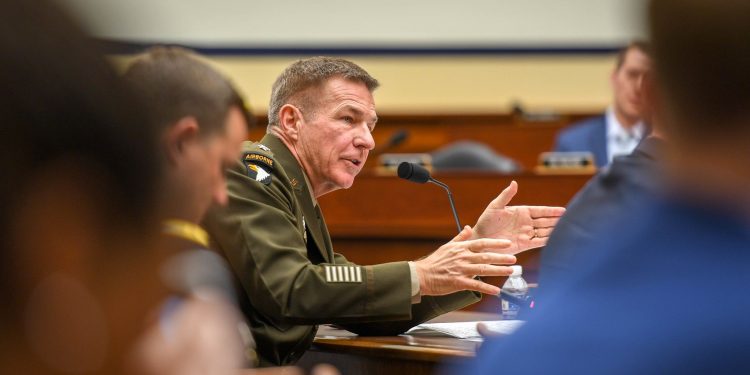The Army will test-fire multiple land-based hypersonic missiles later this year, said Secretary of the Army Ryan D. McCarthy, as leaders zero in on their 2023 goal to deliver high-speed munitions that “fly further, hit their targets, and increase reach and lethality” to the joint fight.
McCarthy and Army Chief of Staff Gen. James C. McConville appeared before the House Armed Services Committee Tuesday in the first of multiple congressional hearings on the fiscal year 2021 budget request, saying long-range precision fires remain the force’s top priority.
Army leaders requested $1.7 billion in FY21 to further develop long-range precision fires, with $800 million set aside for hypersonics. The latest request would help activate a hypersonic missile battery by 2023, McCarthy said.
Along with extended range cannon artillery and precision-strike missiles, the Army has already spent more than $1.3 billion toward its LRPF portfolio, McCarthy said.
In all, Army leaders hope to invest more than $10 billion over the next five years for modernization efforts that include helicopters, ground vehicles, communication networks, next-generation artillery, and air and missile defense programs.
“These portfolios are all performing well,” McCarthy said.
For example, the Army’s extended range cannon artillery, or ERCA, has developed artillery capable of doubling ranges “from the mid-30s to the north of 70 kilometers,” he added.
In addition to modernization efforts, the Army’s $178 billion budget request for next year — released last month — is divided across several other priorities, they said.
To meet the national objectives carved out in the Defense Strategy, the Army –with support of Congress — has developed three distinct priorities: readiness, modernization, and reform, McCarthy said. “We’ve aligned our budget with the same.”
Sixty percent of the budget is locked in for its people, operations and maintenance. The rest of the balance is devoted to its modernization priorities — a total price drop from last year’s $182 billion bid to Congress, despite climbing price tags.
The force’s budget has stayed relatively flat, McCarthy said, even though the demand for Army forces also continues to increase. This demand, coupled with the need to bring new systems online, will call for Army leaders to bump up future budget requests 3 to 5% for real growth in the coming years, he said.
“In this fiscal year, we will increase Soldier touchpoints, test shots, capability demonstrations, and the fielding of our formations,” McCarthy said.
The Army plans to invest $800 million across the next five years toward cloud computing, McCarthy said, “which is central to our modernization effort.”
Officials plan to operationalize the Army’s cloud environment by the first quarter of fiscal 2021, McCarthy said.
“We’re trying to bring together every sensor, every shooter from every service in the battlefield together so we can communicate into the future,” McConville said.
To help do this, the Army is expected to lead the Pentagon’s Close Combat Task Force, a joint effort made up of Marines and Soldiers. However, Marines will remain an integral part of the task force, McConville said.
“The Marine Corps is a fabulous service and they do great things for the country,” McConville said. “We work together very closely, but what the Army brings is a large capability.”
Since the Army provides the largest share of infantry and special operators to the task force, Soldiers could bring ideas and innovations into the field quicker if they lead it, Secretary of Defense Mark Esper said when he initially proposed the likely change in January.
Regardless of what happens, Soldiers will continue to work alongside Marines, McConville assured Congress.
“We’re totally integrated, whether we’ve tested the next-generation squad weapons or the [Integrated Visual Augmentation System],” McCarthy said. “It is a Marine-Soldier-centered design on these weapons systems; we’re investing jointly.”
“This is going to change the way our combat Soldiers, Marines, or Special Forces can rehearse for missions and their ability to go and do it,” McConville said, regarding the IVAS goggles. “It’s like an iPhone capability compared to a dial-up phone.”
“We have Marines and Special Forces training on our systems,” McConville added, “[The IVAS] makes a huge difference, along with the next-generation combat weapons.”
The next generation squad weapons can go through anything on the battlefield out to roughly 600 meters, McConville said. The Army requested more than $111 million to field the new NGSW by 2023.
“It’s pretty amazing how fast [the next-generation weapons are] developing, and it’ll be more amazing when they link into the IVAS system,” McCarthy said, “We’re watching people with marksmanship much greater than they would ever have with it with an iron sight.”
The IVAS goggles have been under testing and development since 2018, are capable of facial recognition, language translation, augmented-reality training, biometrics, and can link up with a weapons sensor. They are expected to be fielded by fiscal 2021.











